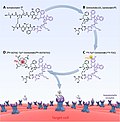Somatostatin receptor
Somatostatin Receptor[edit]
Somatostatin receptors are a group of G protein-coupled receptors (GPCRs) that bind the peptide hormone somatostatin. These receptors are involved in a wide range of biological processes, including the inhibition of hormone secretion, modulation of neurotransmission, and regulation of cell proliferation.
Types of Somatostatin Receptors[edit]
There are five known subtypes of somatostatin receptors, designated as SSTR1, SSTR2, SSTR3, SSTR4, and SSTR5. Each subtype has distinct tissue distribution and functional roles:
- SSTR1: Predominantly found in the central nervous system and gastrointestinal tract.
- SSTR2: Widely expressed in the pituitary gland, pancreas, and gastrointestinal tract.
- SSTR3: Present in the brain, pancreas, and kidney.
- SSTR4: Mainly located in the lung and brain.
- SSTR5: Found in the pituitary gland and pancreas.
Function[edit]
Somatostatin receptors mediate the effects of somatostatin by inhibiting the release of various secondary hormones. For example, in the pituitary gland, somatostatin inhibits the secretion of growth hormone. In the pancreas, it suppresses the release of insulin and glucagon.
Clinical Significance[edit]
Somatostatin receptors are targets for diagnostic and therapeutic applications, particularly in the treatment of neuroendocrine tumors. Radiolabeled somatostatin analogs, such as __Y-DOTATOC, are used in peptide receptor radionuclide therapy (PRRT) to deliver targeted radiation to tumor cells expressing somatostatin receptors.
Related Pages[edit]
-
⁹⁰Y-DOTATOC Structure
Ad. Transform your life with W8MD's Budget GLP-1 injections from $75


W8MD offers a medical weight loss program to lose weight in Philadelphia. Our physician-supervised medical weight loss provides:
- Weight loss injections in NYC (generic and brand names):
- Zepbound / Mounjaro, Wegovy / Ozempic, Saxenda
- Most insurances accepted or discounted self-pay rates. We will obtain insurance prior authorizations if needed.
- Generic GLP1 weight loss injections from $75 for the starting dose.
- Also offer prescription weight loss medications including Phentermine, Qsymia, Diethylpropion, Contrave etc.
NYC weight loss doctor appointmentsNYC weight loss doctor appointments
Start your NYC weight loss journey today at our NYC medical weight loss and Philadelphia medical weight loss clinics.
- Call 718-946-5500 to lose weight in NYC or for medical weight loss in Philadelphia 215-676-2334.
- Tags:NYC medical weight loss, Philadelphia lose weight Zepbound NYC, Budget GLP1 weight loss injections, Wegovy Philadelphia, Wegovy NYC, Philadelphia medical weight loss, Brookly weight loss and Wegovy NYC
|
WikiMD's Wellness Encyclopedia |
| Let Food Be Thy Medicine Medicine Thy Food - Hippocrates |
Medical Disclaimer: WikiMD is not a substitute for professional medical advice. The information on WikiMD is provided as an information resource only, may be incorrect, outdated or misleading, and is not to be used or relied on for any diagnostic or treatment purposes. Please consult your health care provider before making any healthcare decisions or for guidance about a specific medical condition. WikiMD expressly disclaims responsibility, and shall have no liability, for any damages, loss, injury, or liability whatsoever suffered as a result of your reliance on the information contained in this site. By visiting this site you agree to the foregoing terms and conditions, which may from time to time be changed or supplemented by WikiMD. If you do not agree to the foregoing terms and conditions, you should not enter or use this site. See full disclaimer.
Credits:Most images are courtesy of Wikimedia commons, and templates, categories Wikipedia, licensed under CC BY SA or similar.
Translate this page: - East Asian
中文,
日本,
한국어,
South Asian
हिन्दी,
தமிழ்,
తెలుగు,
Urdu,
ಕನ್ನಡ,
Southeast Asian
Indonesian,
Vietnamese,
Thai,
မြန်မာဘာသာ,
বাংলা
European
español,
Deutsch,
français,
Greek,
português do Brasil,
polski,
română,
русский,
Nederlands,
norsk,
svenska,
suomi,
Italian
Middle Eastern & African
عربى,
Turkish,
Persian,
Hebrew,
Afrikaans,
isiZulu,
Kiswahili,
Other
Bulgarian,
Hungarian,
Czech,
Swedish,
മലയാളം,
मराठी,
ਪੰਜਾਬੀ,
ગુજરાતી,
Portuguese,
Ukrainian
